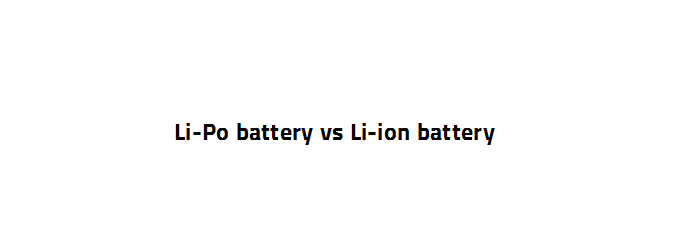
Li-Po vs Li-ion battery,what are the difference between them?
The history of lithium polymer batteries dates back to the 1970s. Their first design included a dry solid polymer electrolyte similar to a plastic film. Therefore, this type of battery can achieve a very thin design while still maintaining a relatively good battery life. In addition, lithium polymer batteries are very light and have a higher level of safety. However, these batteries are more expensiveto manufacture and have a lower energy density than lithium ion batteries.

Lithium-ion batteries began to develop in 1912. However, they were not popular until they were adopted by Sony in 1991. Lithium-ion batteries have high energy density and are less expensive than lithium polymer batteries. In addition, they do not need to be activated for the first time and have a low self-discharge rate. However, lithium-ion batteries do age, and after a while, the ions in the battery lose their ability to produce maximum energy - Even when not in use.

The following analysis of the difference between lithium-ion batteries and polymer lithium batteries from several aspects:
First, the raw materials are different
The raw material of the lithium ion battery is an electrolyte (liquid or colloid); the raw material of the polymer lithium battery is an electrolyte having a polymer electrolyte (solid or colloidal) and an organic electrolyte.
Second, different shaping method
The polymer battery can be thinned, arbitrarily aread, and arbitrarily shaped. It can make into a thin battery: with a capacity of 3.6V400mAh and thickness of 0.5mm. It can also be bent and deformed: the polymer battery can be bent up to about 90° because the electrolyte can be solid in a colloidal state rather than a liquid state.
The lithium battery is an aluminum shell battery, the electrolyte is liquid, and the outer packaging material is an aluminum shell as a secondary package, The electrolyte is contained, and it is not easy to make into other shapes.
On this basis, lithium polymer batteries have some advantages over lithium ion batteries.
- Small thickness, can be made thinner, can be less than 1mm.
- Light weight, 40% lighter than the same capacity of steel shell lithium battery, 20% lighter than aluminum shell battery,
- High power: Due to the structural characteristics of the battery, it is easy to produce products that can discharge 10C, 20C.
Third, the manufacturing process is different
The thinner the polymer battery, the better the production. The thicker the lithium battery, the better the production, which makes the lithium polymer battery more expandable in the field of application. Shapes can be customized - tailored to customer needs, make full use of space, increase capacity, and can quickly convert models, responding quickly to market demand.
Fourth, the capacity
The lithium polymer battery has a large capacity, and the capacity of the lithium-shell battery of the same size is 10% to 15% higher. Due to the better heat dissipation and easy realization of packaging, batteries with a capacity of more than 10Ah are not very difficult for polymer lithium-ion batteries. At present, large-capacity batteries of 30Ah or more do not require special structure and packaging design. Therefore, the development of thin batteries and large capacity batteries is a breakthrough for lithium polymer batteries.
Fifth, different aspects of security
Lithium-ion batteries are easy to explode in high temperature and high pressure environments; lithium polymer batteries has a aluminum plastic film as the outer casing, no battery leakage problem, and the battery contain the colloidal solid instead of liquid electrolyte inside,so even if the liquid is very hot, it would not explode.
Sixth, the battery voltage is different
Since the polymer battery is made of a polymer material, it can be made into a multi-layer combination in the battery cell to achieve a high voltage, and the battery cell has a nominal capacity of 3.6V. To achieve a high voltage in practical use, multiple The cells are connected in series to form the ideal high voltage working platform.
Seventh, charging life
Lithium-ion battery cycles can range from 100 - 300, while lithium polymer batteries can reach 300 - 400 cycles
Eighth ,application
Lithium-ion batteries are mainly used in mobile phones, computers and related accessories, as well as in power tools and digital cameras. Lithium polymer batteries are mainly used in electric toys, backup power supply, portable electronic products, headphones and other Bluetooth products, electric tools, electric vehicles, medical equipment and etc. Because of their characteristics, lithium polymer batteries will be more widely used than lithium ion batteries.




Comments
Leave a comment